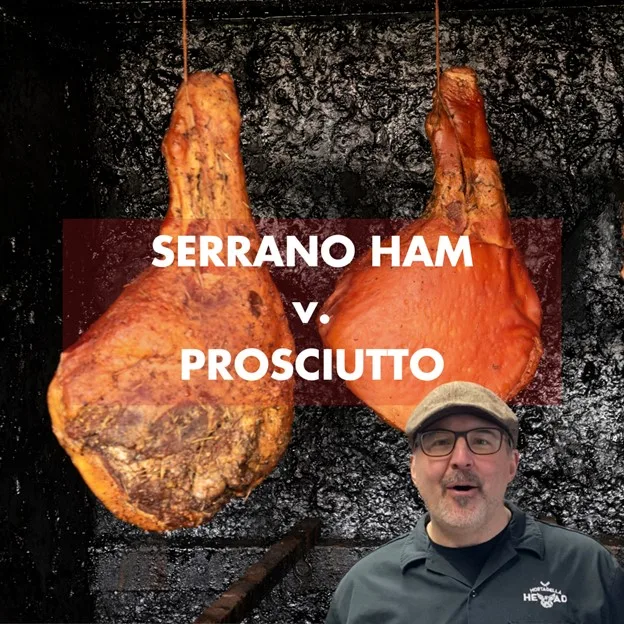Ok. So earlier this month a friend of mine had a ticket to some swanky event at a historic mansion in Newport, Rhode Island. She couldn’t go to the event because she had to fly to California for a last minute trip.
She asked me if I wanted her ticket to the fancy mansion party and I said. “Sure. Why not?”
When I got to the party it was really impressive. The old mansion was all decked out in beautiful Christmas decorations.
The guests at the party were dressed in their fancy party attire walking around with glasses of Champagne and wine.
In the middle of the ballroom there was a massive table loaded with all of the things you’d find on a really good charcuterie board.
What I liked about this table was that most of the items were labeled. So as I made my way around mountains of different types of meat and cheeses, slowly grazing, I knew what I was eating.
There was salami, soppressata and capocollo. Plus a lot of cheeses, dried fruit and nuts. It was beautiful.
I noticed that there was a good selection of Italian prosciutto and Spanish Serrano ham when I got to one end of the table. I’m always a huge sucker for cold cuts, especially a dry-cured ham, so I spent a fair amount of time at that end of the table.
After picking on a fair amount of both types of ham, I started to get curious.
These thin slices of ham were very similar, with some noticeable differences.
They were both salty and sweet with a velvety texture. But I could definitely notice a different flavor in each slice.
I decided that after that night I had to do some research and find out the main differences and similarities between Serrano ham and prosciutto. So here’s what I learned…
The Similarities Between Serrano Ham And Italian Prosciutto
When I eat Serrano ham and prosciutto, it’s obvious that they are very similar. They are both the result of people in the past figuring out a way to preserve meat before the days of refrigeration.
Luckily, because of their ingenuity, we all get to eat some really good food today.
There are many similarities between Serrano ham and Italian prosciutto. This is obvious from looking at them and tasting them.
They both have a rich flavor that is sweet and salty.
They are both a type of ham and are made from the same type of meat. They are a pork product.
Both Serrano ham and Italian prosciutto are made from the hind legs of pigs.
They are both a raw ham. This means they are a cured meat and are not cooked.
The curing process of both hams uses salt, air and time.
In many cases, the curing is done with sea salt. The pork is covered in salt so that the moisture of the meat is drawn out. This prevents it from spoiling.
The production process for both types of ham are similar, although there are some key differences.

Facts About Serrano Ham
I did some research on Serrano ham and I learned a lot. A good part of my research was trying different types of this Spanish ham so I could really understand the flavors and textures.
After a ton of reading and eating, I think I know enough about Serrano ham to confidently write this article.
In Spain they call it jamon Serrano.
The name Serrano is a derivative of the Spanish word “sierra” which means mountain.
This is because historically, this Spanish cured ham was produced in the mountainous regions where the air was warm and dry in the Summer and cold in the Winter. These were the best conditions for curing the pork.
So, to keep it simple, Serrano ham means mountain ham.
In the old days, this ham was made using Iberico pigs. This pig breed dates back thousands of years and is native to Spain and Portugal on the Iberian peninsula.
The meat from Iberian pigs is usually a deep red and looks similar to beef. It has a longer curing time than other breeds of pigs. This has caused a shift in the industry where today, Serrano ham is usually made with other pig breeds.
White pigs are now the norm when making Serrano ham. The Landrace breed of white pig is most common.

The Fanciest Spanish Ham
For special occasions the Iberian ham is pulled out.
The Black Iberian pig is still used to make high end Serrano ham. Some say it’s the highest quality ham in the world.
If you have any Spanish friends, ask them about it.
It is referred to as Pata Negra, which means black hoof in Spanish.
This is because this specific breed of pig has much darker coloring compared to other pigs.
Apparently, these fancy pigs are allowed to roam freely in the mountains and munch on oak acorns. This is why they say the jamon Iberico has such a nutty flavor.
My research has found that a good glass of Spanish wine, manchego cheese and thin slices of Spanish jamon Serrano is the perfect snack.

FACTS ABOUT PROSCIUTTO
The first thing I want to make clear is that this article is focusing on prosciutto crudo. This is the uncooked, raw ham that we all know and love.
In case you didn’t know, “prosciutto” is the Italian word for ham. So when you hear the word, you can be confident that you’re dealing with Italian ham.
There is also prosciutto cotto, which is a cooked ham. I’ll talk about that in an article at a later date.
Prosciutto is made from taking the pork leg, usually the back leg of the pig, and covering it in salt. It is then left to rest over time.
During this time the salt draws the moisture out of the meat eliminating bacteria and preserving it.
Prosciutto is usually made from Landrace, Duroc or similar breeds of white pig. It can also be made with wild boar.
Various Types of Italian Prosciutto
When you go to grocery stores or Italian markets you’ll probably come across a few different types of prosciutto ham.
While prosciutto is made all over Italy in different regions, here are a few of the most popular ones.
Prosciutto di Parma comes from the Emilia-Romagna region in Northern Italy. It is known for its salty and sweet flavor. Sometimes you’ll see it being called Parma ham.
Prosciutto di San Daniele comes from the Friuli-Venezia Giulia region of Italy which is also in the north. Prosciutto San Daniele is actually sweeter and less salty than other Italian-made prosciutto. Some say it’s the highest quality of Italian prosciutto.
Prosciutto Toscano is from Tuscany. It’s cured with salt and additional spices such as black pepper, rosemary and juniper.
My Personal Experience in Making Prosciutto
When I was a kid my grandfather had some friends who made prosciutto in their basements. A few times I helped them do it.
Back then I didn’t think anything of it…when you’re a kid you don’t appreciate stuff like that.
Now, thinking back, I realize how cool that was.
They’d take a raw pig leg and put it in a barrel packed with salt. After some time passed,they would take it out and hang it from the beams in the basement.
I don’t remember the entire process, but I remember going back to the house months later when it was done to taste the final product.
We’d head down to the basement. The prosciutto would be hanging from the ceiling with a nail and a string. There were always a few flies on the prosciutto from what I remember.
Yikes. As a kid I’d be grossed out.
These storage areas probably wouldn’t pass a health inspection.
The guys would drink homemade wine, eat cheese and slice prosciutto with a sharp knife right off of the leg. I remember every ham slice being thick and salty. They didn’t have an electric slicer like the delis.
It was a lot of fun now that I look back.
Anyway, I hope you learned something after reading this article.









